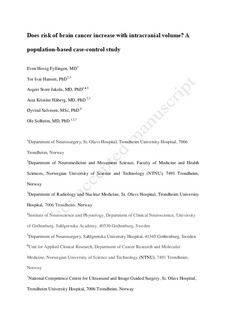Does risk of brain cancer increase with intracranial volume? A population-based case control study
Fyllingen, Even Hovig; Hansen, Tor Ivar; Jakola, Asgeir Store; Håberg, Asta; Salvesen, Øyvind; Solheim, Ole
Journal article, Peer reviewed
Accepted version

Åpne
Permanent lenke
http://hdl.handle.net/11250/2600417Utgivelsesdato
2018Metadata
Vis full innførselSamlinger
Sammendrag
Background
Glioma is the most common primary brain tumor and is believed to arise from glial stem cells. Despite large efforts, there are limited established risk factors. It has been suggested that tissue with more stem cell divisions may exhibit higher risk of cancer due to chance alone. Assuming a positive correlation between the number of stem cell divisions in an organ and size of the same organ, we hypothesized that variation in intracranial volume, as a proxy for brain size, may be linked to risk of high-grade glioma.
Methods
Intracranial volume was calculated from pretreatment 3D T1-weighted MRI brain scans from 124 patients with high-grade glioma and 995 general population–based controls. Binomial logistic regression analyses were performed to ascertain the effect of intracranial volume and sex on the likelihood that participants had high-grade glioma.
Results
An increase in intracranial volume of 100 mL was associated with an odds ratio of high-grade glioma of 1.69 (95% CI: 1.44‒1.98; P < 0.001). After adjusting for intracranial volume, female sex emerged as a risk factor for high-grade glioma (odds ratio for male sex = 0.56, 95% CI: 0.33‒0.93; P = 0.026).
Conclusions
Intracranial volume is strongly associated with risk of high-grade glioma. After correcting for intracranial volume, risk of high-grade glioma was higher in women. The development of glioma is correlated to brain size and may to a large extent be a stochastic event related to the number of cells at risk.